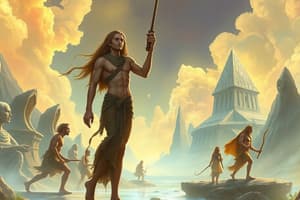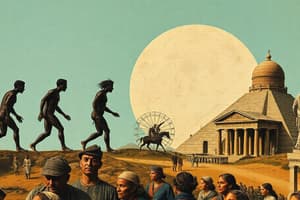Podcast
Questions and Answers
What key stages are along the evolutionary pathway leading to Homo sapiens?
What key stages are along the evolutionary pathway leading to Homo sapiens?
The emergence of early hominins like Australopithecus, followed by more advanced species such as Homo habilis, Homo erectus, and finally, Homo neanderthalensis.
What significant transformation occurred about 12,000 years ago that led humanity away from nomadic hunter-gatherer societies?
What significant transformation occurred about 12,000 years ago that led humanity away from nomadic hunter-gatherer societies?
The dawn of agriculture, which initiated the Neolithic Revolution.
Name some ancient civilizations that emerged independently across different regions of the world.
Name some ancient civilizations that emerged independently across different regions of the world.
Sumerians, Egyptians, Indus Valley, China's Shang Dynasty, Olmecs, Maya, Inca Empire, Aztecs, Greeks, Persians, Romans.
When did ancestral apes from Africa give birth to the genus Homo?
When did ancestral apes from Africa give birth to the genus Homo?
What was the outcome of the Neolithic Revolution?
What was the outcome of the Neolithic Revolution?
What role did global trade play in shaping the social, economic, and political landscape?
What role did global trade play in shaping the social, economic, and political landscape?
Describe the impact of the European Renaissance on arts and sciences.
Describe the impact of the European Renaissance on arts and sciences.
What were some key Enlightenment ideas that shaped modern societies?
What were some key Enlightenment ideas that shaped modern societies?
How did technological progress impact modern societies?
How did technological progress impact modern societies?
What is history's role in understanding human resilience and adaptation?
What is history's role in understanding human resilience and adaptation?
Flashcards are hidden until you start studying
Study Notes
Unraveling Human History: A Journey Through Time
Throughout our existence on this planet, humans have been writing stories of survival, adaptation, growth, and transformation. As we delve into history's tapestry, let's discover some pivotal threads interwoven throughout human development—beginning with our first ancestors' humble beginnings millions of years ago.
Early Humans
Our species traces its roots back to around seven million years ago when ancestral apes from Africa gave birth to the genus Homo, leading eventually to Homo sapiens. Key stages along the evolutionary pathway include the emergence of early hominins like Australopithecus followed by more advanced species such as Homo habilis, Homo erectus, and finally, Homo neanderthalensis.
The Neolithic Age
About 12,000 years ago during the dawn of agriculture, humanity underwent one of its most significant transformations, moving away from nomadic hunter-gatherer societies towards sedentary farming communities. This transition, known as the Neolithic Revolution, led to population growth, increased food production, and the rise of civilizations.
Ancient Civilizations
Civilization emerged independently several times across different regions of the world, giving us a vivid image of ancient cultures such as Sumerians, Egyptians, Indus Valley, China's Shang Dynasty, Olmecs, Maya, Inca Empire, Aztecs, Greeks, Persians, Romans, among others. These empires developed their unique cultural identities, written languages, governments, art forms, and religious beliefs, contributing immensely to humanity's collective memory.
The Spread of Global Trade & Empires
From the Old World's maritime trade routes established by Phoenicians, Carthaginians, and later, Arabs, to Asian Silk Roads connecting East Asia and Central Asia, global exchange played a critical role in shaping the broader social, economic, political, and intellectual landscape over centuries. Concurrently, vast land-based territorial empires expanded exponentially, fostering technological advancements, philosophical debates, scientific discoveries, and political rivalries.
Medieval Period & Renaissance
Beginning with the fall of Rome through the Middle Ages, Europe entered a period called Pax Romana, marked by feudalism, monastery scriptoria, and medieval guilds. Following this came the flowering of arts and sciences during the European Renaissance, which rekindled interest in classical literature, philosophy, mathematics, and science. The era also saw pioneers like Christopher Columbus embarking on seafaring voyages to unknown lands, thereby laying foundations for future explorations and colonization efforts.
The Modern Era & Contemporary Times
Enlightenment ideas of individual liberty, democracy, rule of law, equality, and free markets shaped modern societies worldwide. Technological progress brought monumental changes, including industrial revolutions, rapid urbanization, mass communication networks, and space exploration. However, it equally introduced conflicts and challenges regarding human rights, social justice, environmental protection, global security, and geopolitical order.
History is an ever-evolving story of resilience, adaptation, learning, and change. By studying events from our ancestors' earliest days to contemporary society, each generation can appreciate how far humans have come and find wisdom in understanding where our paths may lead next.
Studying That Suits You
Use AI to generate personalized quizzes and flashcards to suit your learning preferences.




